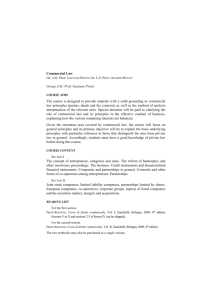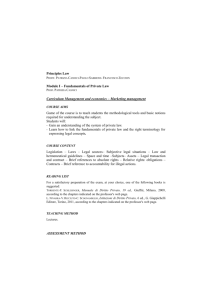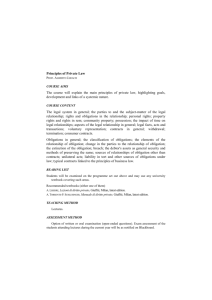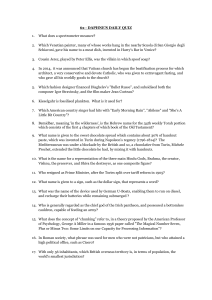Commercial Law
advertisement
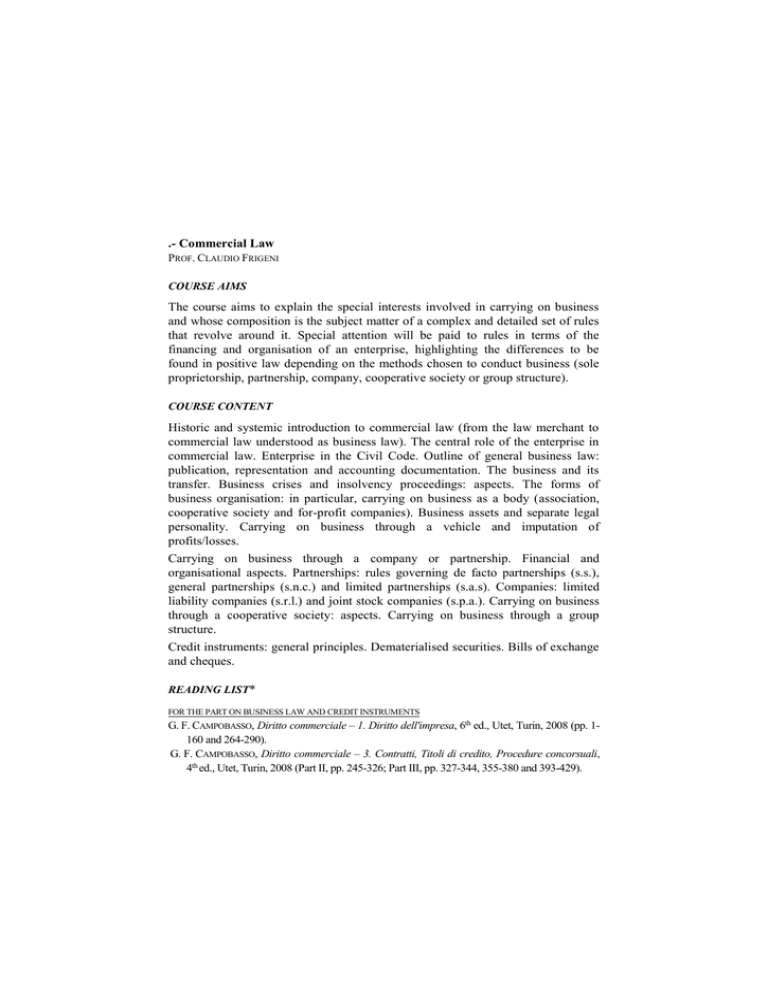
.- Commercial Law PROF. CLAUDIO FRIGENI COURSE AIMS The course aims to explain the special interests involved in carrying on business and whose composition is the subject matter of a complex and detailed set of rules that revolve around it. Special attention will be paid to rules in terms of the financing and organisation of an enterprise, highlighting the differences to be found in positive law depending on the methods chosen to conduct business (sole proprietorship, partnership, company, cooperative society or group structure). COURSE CONTENT Historic and systemic introduction to commercial law (from the law merchant to commercial law understood as business law). The central role of the enterprise in commercial law. Enterprise in the Civil Code. Outline of general business law: publication, representation and accounting documentation. The business and its transfer. Business crises and insolvency proceedings: aspects. The forms of business organisation: in particular, carrying on business as a body (association, cooperative society and for-profit companies). Business assets and separate legal personality. Carrying on business through a vehicle and imputation of profits/losses. Carrying on business through a company or partnership. Financial and organisational aspects. Partnerships: rules governing de facto partnerships (s.s.), general partnerships (s.n.c.) and limited partnerships (s.a.s). Companies: limited liability companies (s.r.l.) and joint stock companies (s.p.a.). Carrying on business through a cooperative society: aspects. Carrying on business through a group structure. Credit instruments: general principles. Dematerialised securities. Bills of exchange and cheques. READING LIST* FOR THE PART ON BUSINESS LAW AND CREDIT INSTRUMENTS G. F. CAMPOBASSO, Diritto commerciale – 1. Diritto dell'impresa, 6th ed., Utet, Turin, 2008 (pp. 1160 and 264-290). G. F. CAMPOBASSO, Diritto commerciale – 3. Contratti, Titoli di credito, Procedure concorsuali, 4th ed., Utet, Turin, 2008 (Part II, pp. 245-326; Part III, pp. 327-344, 355-380 and 393-429). alternatively M. CIAN. (ED.), Diritto commerciale, Giappichelli, Turin, 2013, Vol. I, (pp. 1-166, 277-360 and 436-450) FOR THE PART ON COMPANY LAW G. F. CAMPOBASSO, Diritto commerciale – 2. Società, 8th ed., Utet, Turin, 2012 (pp. 1-699). alternatively M. CIAN. (ED.), Diritto commerciale, Giappichelli, Turin, 2013, Vol. II, (pp. 1-784 and 885-918) alternatively G. PRESTI – M. RESCIGNO, Corso di diritto commerciale – II. Società, 5th ed., Zanichelli, Bologna, 2011 (pp. 1-357). Students attending lectures may be assigned other textbooks to use for the exam. * Students are informed that the insolvency law portion of the course programme is an integral part of the exam also for any student who has included Insolvency Law in their own study plan. TEACHING METHOD Lectures that mainly adopt a seminar-style approach, which presupposes knowledge of parts of the textbooks from time to time specified and the additional material (academic writings and caselaw) made available in advance through the Blackboard platform. All students are advised to master basic Blackboard functions. During the course tutorials may be held so as examine some specific topics in depth. ASSESSMENT METHOD Oral examination in a single session only. NOTES Students must first have passed the exam on Principles of Private Law before sitting the exam for Commercial Law. It is indispensible that students use an up-to-date version of the Civil Code that includes the associated laws. Students must know about any legislative or regulatory changes that may occur during the course of the year, details of which will be published on Blackboard and on the lecturer’s webpage (http://docenti.unicatt.it/ita/claudio_frigeni/). Further information can be found on the lecturer's webpage at http://docenti.unicatt.it/web/searchByName.do?language=ENG or on the Faculty notice board.
